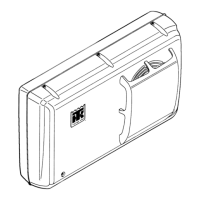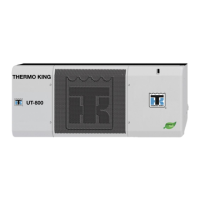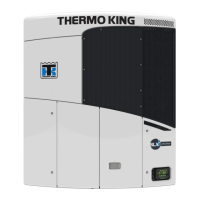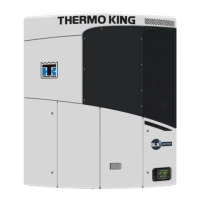Refrigeration Maintenance and Service Operations
135
Gauge Manifold Set Removal
NOTE: To ensure minimum refrigerant release
to the atmosphere, THE SYSTEM SHOULD BE
RUNNING. However, this is not possible in all
cases, but the same procedure should be
followed.
1. Rotate discharge hose fitting hand wheel
counterclockwise to withdraw the fitting stem
from the discharge line port valve. Then open
both service manifold valves to center port.
2. Operate the unit on Cool using the
“CAPACITY 100%” test from the Manual
Function Test menu of the controller.
3. Rotate the suction hose coupler hand wheel
counterclockwise to withdraw the fitting stem
from the suction line port valve. Then turn the
unit off.
4. Remove the gauge lines from the suction and
discharge service fittings and cap the service
ports.
5. Secure all manifold lines to manifold hose
anchors when the manifold is not in use.
Checking Compressor Oil
The compressor oil should be checked during
pre-trip inspections and when there is evidence of
oil loss (oil leaks) or when components in the
refrigeration system have been removed for
service or replacement.
To Check Compressor Oil Level with
an Ambient Air Temperature Above
10 C (50 F)
Install gauge manifold on the compressor. Operate
the unit on Cool with a 138 kPa, 1.38 bar, 20 psig
minimum suction pressure and a 689 kPa, 6.89
bar, 100 psig discharge pressure for 15 minutes or
more. After the unit has maintained the above
conditions for 15 minutes, observe the compressor
oil level. The oil should be 1/2 to 3/4 up in the
sight glass.
To Check Compressor Oil Level with
an Ambient Air Temperature Below
10 C (50 F)
With the evaporator temperature below 10 C
(50 F), initiate a Manual Defrost to operate the
unit through a complete Defrost cycle. After
completing the defrost cycle, operate the unit on
Cool for a few minutes. After 2 to 3 minutes,
observe the oil level. The oil should be 1/2 to 3/4
up in the sight glass.
If the container is empty, you can operate the unit
on the heat cycle instead of the defrost cycle.
CAUTION: Rubber gloves are
recommended when handling Ester based
compressor oil.
CAUTION: Use ONLY Polyol Ester based
refrigeration compressor oil, refer to Tool
Catalog.
CAUTION: DO NOT mix Polyol Ester
based and standard synthetic compressor
oils.
CAUTION: Rubber gloves are
recommended when handling Ester based
compressor oil.
CAUTION: Keep Polyol Ester based
compressor oil in tightly sealed
containers. If Ester based oil becomes
contaminated with moisture or standard
oils, dispose of properly — DO NOT USE!
1.
Add and Remove Compressor Oil at the
Compressor Oil Fitting
Figure 47: Adjusting Compressor Oil Level
AXA0245
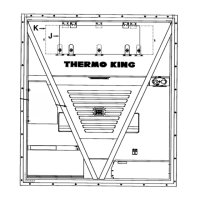
